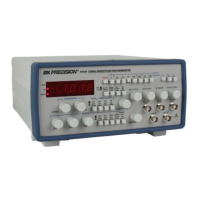AMPLIFIER OVERLOAD
CHARACTERISTICS
The overload point for some amplifiers is
difficult to determine using a sine wave input.
The triangle waveform is ideal for this type of
test because any departure from absolute lin-
earity is readily detectable. Using the triangle
output, the peak overload condition for an
amplifier can be easily determined. T h i s
overload condition is shown in Fig. 8.
FREQUENCYRESPONSE
MEASUREMENTS, LINEAR DISPLAY
Introduction
Function generators with sweep capabili-
ty are ideal for checking the frequency
response of such devices as amplifiers, bass
and treble controls, bandpass filters, low or
high pass filters, coupling networks, speakers
and speaker enclosures, IF amplifier strips,
tuned circuits, notch filters, and any imped-
ance network. Since the range of modern
function generators is at least 1 MHz and
higher, they can provide the means for mea-
suring, adjusting, and analyzing the response
of any active or passive device up to that
range.
In addition to internal sweep, many gen-
erators feature a VCF input which permits
sweep control by sine waves or other special
patterns. Also, many units enable the entire
audio range of 20 Hz to 20 kHz to be covered
in one single sweep for convenience.
Test Set-up
The following procedure, along with Fig.
9, describes the typical set-up and method for
measuring frequency response.
1. Select the desired frequency range on the
generator.
2. Connect a cable from the GCV output
jack on the generator to the horizontal
(X) input of the oscilloscope.
3. Set the oscilloscope for X-Y operation,
and select DC coupling for the X input.
4. With the generator’s sweep turned off,
vary the basic operating frequency of the
unit. The GCV output will cause the dot
on the scope screen to deviate from left to
right. Direction of the deviation depends
on the particular generator. Some move to
the right as frequency is increased, and
some to the left.
5. Use a grease pencil or china marker and
APPLICATIONS
FIG. 7. Use of a function generator as combined bias supply and signal source.
FIG. 8. Amplifier overload characteristics.
FIG. 9. Frequency response test set-up and measurement.
10
(may be inverted by
some amplifiers)

